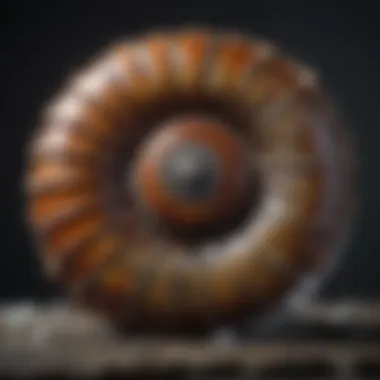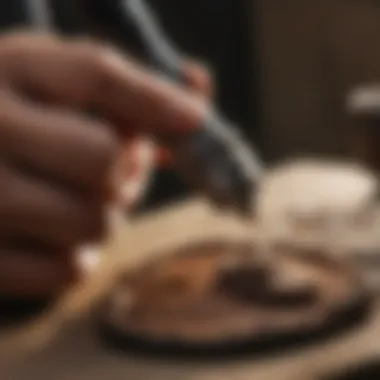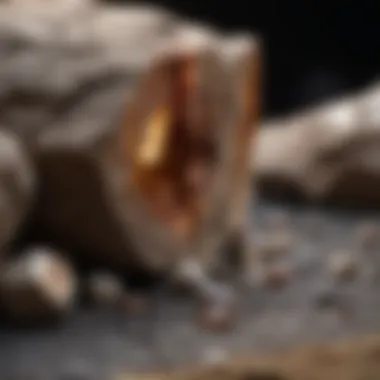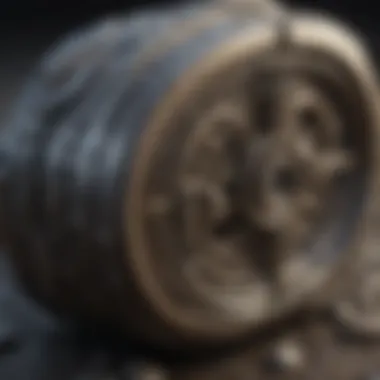Unlocking the Secrets of Dremel Polishing Bits for Rock and Fossil Enthusiasts


Rock and Fossil Identification
Rock and fossil identification is a fundamental aspect of the world of Dremel polishing bits for rock and fossil collectors. Understanding the types of rocks and fossils is crucial for collectors to enhance their skills in polishing geological specimens. Various characteristics need to be closely examined when identifying rocks and fossils, such as color, texture, hardness, and specific patterns that signify different types of geological specimens. Utilizing the right tools for identification, including magnifying glasses, hardness picks, and geology hammers, is essential in accurately determining the composition of rocks and fossils.
Collecting Tips and Techniques
In the realm of rock and fossil collecting, mastering the best practices and techniques is vital for enthusiasts looking to expand their collections. Collectors need to know how to locate prime collecting sites where geological specimens are abundant. Researching and networking with other collectors can provide valuable insights into discovering new sites. Extracting specimens safely is key to preserving the integrity of the rocks and fossils. Tools like chisels, brushes, and protective gear should be used to carefully remove specimens from their geological setting without causing damage.
Preservation and Display
Preservation and display play a significant role in showcasing and maintaining the beauty of rocks and fossils. Techniques for preserving geological specimens vary depending on their composition, with methods ranging from using consolidants to prevent flaking to creating protective coatings to maintain color and luster. Proper storage is essential to prevent deterioration, with collectors opting for acid-free paper, cotton, or foam for cushioning. Creative display ideas, such as shadow boxes, glass domes, or custom stands, can amplify the aesthetic appeal of rock and fossil collections.
Geological Insights
Delving into the geological insights surrounding rocks and fossils provides collectors with a deeper understanding of the Earth's history and processes. Exploring geological formations and processes, such as sedimentation and metamorphism, can offer valuable insights into the formation of different types of rocks and fossils. Understanding the historical significance of specific geological specimens can enrich the collector's appreciation for rare finds. Notable discoveries in the field, including new species or unique geological occurrences, contribute to the ever-evolving landscape of rock and fossil collecting.
Introduction to Dremel Polishing Bits
In the intricate realm of rock and fossil collection, the importance of Dremel polishing bits cannot be overstated. These tools serve as the gateway to enhancing the aesthetic appeal, revealing hidden details, and preserving specimens with precision and finesse. By understanding the diverse types and functions of polishing bits, collectors can elevate their skills and unlock the true beauty of geological treasures.
Understanding the Importance of Polishing in Rock and Fossil Collection
Enhancing Aesthetic Appeal
Among the crucial aspects of polishing in rock and fossil collection is enhancing the aesthetic appeal of specimens. This process involves bringing out the natural luster and beauty of rocks and fossils, making them visually captivating. By using Dremel polishing bits, collectors can achieve a polished finish that highlights the intricate textures and colors of each specimen, adding a touch of elegance to their collection.
Revealing Hidden Details
Another essential aspect of polishing is revealing hidden details within rocks and fossils. Dremel polishing bits have the ability to unveil intricate patterns, delicate structures, and hidden features that may not be noticeable at first glance. This process adds depth and dimension to the specimens, allowing collectors to appreciate the geological history encapsulated within each piece.
Preserving Specimens
In the realm of rock and fossil collection, preserving specimens is a pivotal task. Polishing with Dremel bits helps protect the integrity of rocks and fossils by creating a smooth and durable surface. This protective layer not only enhances the longevity of specimens but also safeguards them from damage or decay over time, ensuring that the beauty and integrity of each piece are maintained for years to come.
Types of Dremel Polishing Bits
Diamond-Coated Bits


One of the most versatile types of Dremel polishing bits is the diamond-coated variety. Known for their exceptional hardness and durability, diamond-coated bits are ideal for polishing hard rocks and transforming rough surfaces into smooth, glossy finishes. These bits excel in shaping and refining gemstones, crystals, and other challenging materials, making them a popular choice for collectors seeking precision and quality in their polishing endeavors.
Felt Polishing Bits
Felt polishing bits offer a softer touch when it comes to polishing delicate rocks and fossils. These bits are designed to provide a gentle yet effective polishing experience, making them suitable for more fragile specimens that require a subtle approach. With their ability to create a smooth and polished surface without causing damage, felt polishing bits are favored for their versatility and ability to enhance the natural beauty of softer rocks and fossils.
Rubber Polishing Bits
For collectors looking to achieve a fine, satin-like finish on their specimens, rubber polishing bits are the go-to choice. These bits are well-suited for creating a soft sheen and matte appearance on a variety of rocks and fossils, adding a distinctive aesthetic quality to each piece. With their flexibility and versatility, rubber polishing bits are indispensable tools for customizing finishes and textures to suit different preferences and styles.
Choosing the Right Polishing Bit for Your Specimen
Considering Material Hardness
When selecting a polishing bit for your specimens, considering the hardness of the material is paramount. Harder rocks and fossils require a more abrasive and durable bit to achieve the desired polish, while softer materials may need a gentler approach to avoid damage. By matching the material hardness with the appropriate polishing bit, collectors can ensure that each specimen is polished effectively and safely, preserving its natural beauty and integrity.
Surface Texture
The surface texture of a specimen plays a crucial role in determining the type of polishing bit to use. Smooth surfaces may require a finer grit bit to refine and polish, while rough textures may benefit from a more abrasive bit to smoothen and level the surface. By evaluating the surface texture of each specimen, collectors can choose the right polishing bit that will enhance the unique characteristics of the rock or fossil, bringing out its inherent beauty and detail.
Final Finish Desired
Before embarking on the polishing process, determining the final finish desired for each specimen is essential. Whether aiming for a high-gloss shine, a satin-like sheen, or a matte finish, selecting the appropriate polishing bit is crucial in achieving the desired outcome. By understanding the effect of different polishing bits on the final finish, collectors can customize their polishing approach to suit the aesthetics and vision they have for their valuable specimens.
Polishing Techniques and Best Practices
In the realm of rock and fossil collection, mastering the art of polishing is paramount. Polishing techniques play a crucial role in enhancing the aesthetic appeal of specimens, revealing intricate details that may be hidden, and preserving specimens for years to come. Rock and fossil collectors understand the importance of using the right polishing techniques to showcase the beauty of their finds to the fullest. Successful polishing techniques and best practices can truly elevate the collecting experience to new heights.
Preparing Your Specimen for Polishing
Cleaning and Drying:
One of the initial steps in the polishing process is preparing the specimen by cleaning and drying it thoroughly. This step ensures that any debris or dirt is removed from the surface, allowing for a smooth and even polishing process. Cleaning and drying are essential to achieving a flawless final finish, enhancing the overall appearance of the specimen. By ensuring the specimen is clean and dry before polishing, collectors can avoid unwanted imperfections and achieve the desired result effectively.
Securing the Specimen:
Securing the specimen in place is another vital aspect of preparing for the polishing process. Properly securing the specimen ensures stability during the polishing, preventing any slippage or mishaps. This step is crucial to maintain the integrity of the specimen and avoid any potential damage. By securing the specimen adequately, collectors can focus on the polishing process without worrying about the specimen moving or shifting.


Step-by-Step Polishing Process
Initial Rough Polishing:
The initial rough polishing stage involves using coarse polishing bits to remove any prominent imperfections or rough spots on the specimen's surface. This step sets the foundation for the subsequent polishing stages, smoothing out the rough areas and preparing the specimen for further refinement. Initial rough polishing is essential for achieving a uniform surface texture and shape before progressing to finer polishing grits.
Progressive Smoothing:
Progressive smoothing consists of gradually refining the surface of the specimen using increasingly finer polishing bits. This stage focuses on smoothing out any remaining roughness or scratches from the initial rough polishing, resulting in a more polished and refined appearance. Progressive smoothing allows collectors to achieve a consistent and flawless finish, enhancing the overall quality of the specimen.
Final Buffing:
The final buffing stage is the last step in the polishing process, aimed at achieving a mirror-like finish on the specimen. This stage involves using soft polishing bits to buff the surface to a high shine, highlighting the natural beauty and intricate details of the specimen. Final buffing adds the perfect final touch to the polished specimen, creating a stunning visual impact.
Safety Measures During Polishing
Eye Protection:
Eye protection is essential during the polishing process to safeguard against any debris or particles that may be generated. Using safety goggles or glasses helps prevent eye injuries and ensures a safe working environment. Eye protection is non-negotiable when engaging in polishing activities to protect the eyes from potential harm.
Dust Mask:
Wearing a dust mask is crucial to protect the respiratory system from inhaling harmful dust particles during the polishing process. Dust masks filter out airborne particles, reducing the risk of respiratory issues or discomfort. Collectors must prioritize wearing a dust mask to maintain good respiratory health while polishing specimens.
Secure Workspace:
Having a secure workspace is fundamental to ensuring a safe and productive polishing environment. A stable work surface and organized tool setup promote efficiency and prevent accidents. A secure workspace minimizes the risk of mishaps or injuries, allowing collectors to focus on the polishing process without distractions or safety concerns.
Advanced Tips for Polishing Excellence
In the realm of rock and fossil collection, mastering the art of polishing is essential for elevating the beauty of geological specimens. Advanced tips for polishing excellence play a pivotal role in achieving remarkable results. These tips go beyond the basics, offering intricate techniques and insights that separate amateurs from experts. By understanding and implementing these advanced tips, collectors can unlock the full potential of their specimens, creating stunning displays that showcase the inherent beauty of rocks and fossils.
When it comes to polishing excellence, utilizing polishing compounds is a game-changer. These compounds act as enhancers, bringing out the natural luster and shine of specimens. Understanding the types of compounds available is crucial for selecting the most suitable one for specific materials and desired finishes. Each type of compound has its unique qualities, ranging from coarse abrasives to fine polishes. By choosing the right compound, collectors can achieve smooth, glossy surfaces or textured finishes, depending on their preferences.
Utilizing Polishing Compounds
Types of Compounds


Types of compounds are diverse, each tailored to address different polishing needs. For instance, abrasive compounds are ideal for removing scratches and leveling surfaces, while finer polishing compounds excel in bringing out a mirror-like shine. The key characteristic of compounds lies in their abrasive properties, which vary based on grain size and composition. By understanding these differences, collectors can select the most effective compound for the specific materials they are working with. While abrasive compounds are adept at shaping rough surfaces, polishing compounds provide the finesse needed for a flawless finish.
Application Techniques
Applying polishing compounds correctly is as crucial as choosing the right type. The technique used affects the outcome of the polishing process significantly. Whether buffing by hand or using a Dremel tool, the application technique determines the level of sheen and smoothness achieved. Proper application distributes the compound evenly, preventing overuse or underuse that could affect the final results. With the right application technique, collectors can maximize the potential of polishing compounds, achieving professional-level finishes that enhance the aesthetic appeal of their specimens.
Achieving Mirror-like Finishes
Final Polishing Stages
In the quest for mirror-like finishes, the final polishing stages play a critical role. These stages involve meticulous attention to detail, ensuring that every imperfection is addressed to achieve a flawless surface. The key characteristic of final polishing stages is their ability to refine the specimen to perfection, eliminating any trace of blemishes or inconsistencies. By dedicating time and effort to these stages, collectors can transform rough rocks and fossils into gleaming masterpieces that reflect light beautifully.
Troubleshooting Common Polishing Issues
Scratches and Blemishes
Despite best efforts, scratches and blemishes can sometimes mar the polishing process. Recognizing the causes of these imperfections is the first step toward resolving them effectively. The key characteristic of scratches and blemishes lies in their ability to diminish the overall visual appeal of specimens. By understanding the root of these issues, collectors can implement targeted solutions, such as adjusting polishing techniques or switching to finer compounds, to rectify the problem and restore the specimen's pristine appearance.
Overheating
Overheating is a common issue during polishing, especially with delicate materials or prolonged polishing sessions. Understanding the causes and consequences of overheating is crucial for preventing damage to specimens. The key characteristic of overheating is its potential to alter the structural integrity of rocks and fossils, leading to discoloration or even fractures. By monitoring temperature levels and allowing adequate cooling periods, collectors can safeguard their specimens from the damaging effects of overheating, ensuring a successful and safe polishing process.
Exploration and Experimentation with Polishing Bits
In the incredible world of Dremel polishing bits, exploring and experimenting with different techniques is essential for rock and fossil collectors aiming to enhance their specimens. It offers a gateway to unlocking unique textures and finishes that can elevate the aesthetic appeal of collected items. By delving into Exploration and Experimentation with Polishing Bits, collectors can uncover innovative ways to customize their specimens, adding a personal touch to each piece.
Creating Unique Textures and Finishes
Etching Patterns
Etching patterns present a fascinating dimension to the polishing process. They contribute significantly to the overall enhancement of rock and fossil specimens. The key characteristic of etching patterns lies in their ability to add intricate designs and textures that highlight the natural beauty of the material. This choice proves popular in the realm of collectors due to its ability to reveal hidden details and create a unique visual appeal for each specimen. The unique feature of etching patterns is their versatility in bringing out the individuality of each rock or fossil, providing a custom finish that distinguishes one piece from another.
Shiny Gloss Finishes
When it comes to adding a professional touch to geological specimens, shiny gloss finishes play a vital role. These finishes contribute significantly to achieving a polished and refined look for rocks and fossils. The key characteristic of shiny gloss finishes is their ability to create a smooth and reflective surface that enhances the beauty of the specimen. This choice is beneficial as it provides a high-end finish that showcases the material's natural qualities effectively. The unique feature of shiny gloss finishes is their ability to increase the visual appeal of the specimen, making it a popular choice among collectors seeking to display their items beautifully.
Customizing Polishing for Different Specimens
Soft vs. Hard Materials
The consideration of soft versus hard materials in polishing is crucial for collectors looking to tailor their techniques to the specific nature of each specimen. Soft materials require a gentler approach to avoid damage, while hard materials can withstand more aggressive polishing methods. The key characteristic of this comparison lies in understanding the material's hardness to determine the appropriate polishing intensity. This choice proves beneficial as it ensures that the polishing process is tailored to preserve the specimen's structure while achieving the desired finish. The unique feature of considering soft versus hard materials is the ability to adapt polishing techniques for optimal results, showcasing the distinct qualities of each specimen effectively.
Natural vs. Synthetic
Differentiating between natural and synthetic specimens influences the customization of polishing techniques in rock and fossil collection. Natural specimens come with unique characteristics that require a delicate polishing approach to maintain their integrity, while synthetic specimens offer more consistency in texture and hardness. The key characteristic of this comparison is acknowledging the origin of the material to determine the appropriate polishing method for best results. This choice is popular as it ensures that the polishing process enhances the intrinsic beauty of natural specimens and provides a uniform finish for synthetic materials. The unique feature of considering natural versus synthetic specimens lies in tailoring polishing techniques to amplify the authentic qualities of natural rocks and fossils, creating a visually striking display for collectors.







